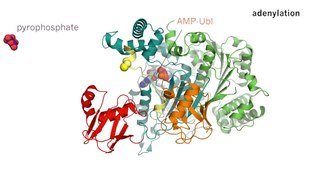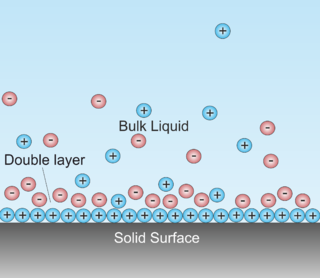Related Research Articles

Electrochemistry is the branch of physical chemistry concerned with the relationship between electrical potential difference and identifiable chemical change. These reactions involve electrons moving via an electronically-conducting phase between electrodes separated by an ionically conducting and electronically insulating electrolyte.

An electrode is an electrical conductor used to make contact with a nonmetallic part of a circuit. Electrodes are essential parts of batteries that can consist of a variety of materials depending on the type of battery.

Physical chemistry is the study of macroscopic and microscopic phenomena in chemical systems in terms of the principles, practices, and concepts of physics such as motion, energy, force, time, thermodynamics, quantum chemistry, statistical mechanics, analytical dynamics and chemical equilibria.

Redox is a type of chemical reaction in which the oxidation states of a reactant change. Oxidation is the loss of electrons or an increase in the oxidation state, while reduction is the gain of electrons or a decrease in the oxidation state.
Revaz Dogonadze was a notable Georgian scientist, Corresponding Member of the Georgian National Academy of Sciences (GNAS) (1982), Doctor of Physical & Mathematical Sciences (1966), Professor (1972), one of the founders of quantum electrochemistry,

Alexander Naumovich Frumkin was a Soviet Russian electrochemist, member of the Russian Academy of Sciences since 1932, founder of the Russian Journal of Electrochemistry Elektrokhimiya and receiver of the Hero of Socialist Labor award. The Russian Academy of Sciences' A.N. Frumkin Institute of Physical Chemistry and Electrochemistry is named after him.
Chemical physics is a branch of physics that studies chemical processes from a physical point of view. It focuses on understanding the physical properties and behavior of chemical systems, using principles from both physics and chemistry. This field investigates physicochemical phenomena using techniques from atomic and molecular physics and condensed matter physics.

In electrochemistry, cyclic voltammetry (CV) is a type of potentiodynamic measurement. In a cyclic voltammetry experiment, the working electrode potential is ramped linearly versus time. Unlike in linear sweep voltammetry, after the set potential is reached in a CV experiment, the working electrode's potential is ramped in the opposite direction to return to the initial potential. These cycles of ramps in potential may be repeated as many times as needed. The current at the working electrode is plotted versus the applied voltage to give the cyclic voltammogram trace. Cyclic voltammetry is generally used to study the electrochemical properties of an analyte in solution or of a molecule that is adsorbed onto the electrode.
Mikhail Vladimirovich Volkenshtein was a notable Soviet and Russian biophysicist, Corresponding Member of the Russian Academy of Sciences, Professor and Doctor of Sciences. In his publications in English his name is written as M. V. Volkenstein.

Electron transfer (ET) occurs when an electron relocates from an atom or molecule to another such chemical entity. ET is a mechanistic description of certain kinds of redox reactions involving transfer of electrons.
Bernhardt Patrick John O’Mara Bockris was a South African professor of chemistry, latterly at Texas A&M University. During his long and prolific career he published some 700 papers and two dozen books. His best known work is in electrochemistry but his output also extended to environmental chemistry, photoelectrochemistry and bioelectrochemistry. In the 1990s he experimented with cold fusion and transmutation, topics on which his unorthodox views provoked controversy.
In theoretical chemistry, Marcus theory is a theory originally developed by Rudolph A. Marcus, starting in 1956, to explain the rates of electron transfer reactions – the rate at which an electron can move or jump from one chemical species (called the electron donor) to another (called the electron acceptor). It was originally formulated to address outer sphere electron transfer reactions, in which the two chemical species only change in their charge with an electron jumping (e.g. the oxidation of an ion like Fe2+/Fe3+), but do not undergo large structural changes. It was extended to include inner sphere electron transfer contributions, in which a change of distances or geometry in the solvation or coordination shells of the two chemical species is taken into account (the Fe-O distances in Fe(H2O)2+ and Fe(H2O)3+ are different).

Enzyme catalysis is the increase in the rate of a process by a biological molecule, an "enzyme". Most enzymes are proteins, and most such processes are chemical reactions. Within the enzyme, generally catalysis occurs at a localized site, called the active site.

In surface science, a double layer is a structure that appears on the surface of an object when it is exposed to a fluid. The object might be a solid particle, a gas bubble, a liquid droplet, or a porous body. The DL refers to two parallel layers of charge surrounding the object. The first layer, the surface charge, consists of ions which are adsorbed onto the object due to chemical interactions. The second layer is composed of ions attracted to the surface charge via the Coulomb force, electrically screening the first layer. This second layer is loosely associated with the object. It is made of free ions that move in the fluid under the influence of electric attraction and thermal motion rather than being firmly anchored. It is thus called the "diffuse layer".
Heinz Gerischer was a German chemist who specialized in electrochemistry. He was the thesis advisor of future Nobel laureate Gerhard Ertl.
Electrochemical engineering is the branch of chemical engineering dealing with the technological applications of electrochemical phenomena, such as electrosynthesis of chemicals, electrowinning and refining of metals, flow batteries and fuel cells, surface modification by electrodeposition, electrochemical separations and corrosion.
Water oxidation is one of the half reactions of water splitting:
Scanning electrochemical microscopy (SECM) is a technique within the broader class of scanning probe microscopy (SPM) that is used to measure the local electrochemical behavior of liquid/solid, liquid/gas and liquid/liquid interfaces. Initial characterization of the technique was credited to University of Texas electrochemist, Allen J. Bard, in 1989. Since then, the theoretical underpinnings have matured to allow widespread use of the technique in chemistry, biology and materials science. Spatially resolved electrochemical signals can be acquired by measuring the current at an ultramicroelectrode (UME) tip as a function of precise tip position over a substrate region of interest. Interpretation of the SECM signal is based on the concept of diffusion-limited current. Two-dimensional raster scan information can be compiled to generate images of surface reactivity and chemical kinetics.
In electrochemistry, protein film voltammetry is a technique for examining the behavior of proteins immobilized on an electrode. The technique is applicable to proteins and enzymes that engage in electron transfer reactions and it is part of the methods available to study enzyme kinetics.
Adiabatic electron-transfer is a type of oxidation-reduction processes. The mechanism is ubiquitous in nature in both the inorganic and biological spheres. Adiabatic electron-transfers proceed without making or breaking chemical bonds. Adiabatic electron-transfer can occur by either optical or thermal mechanisms. Electron transfer during a collision between an oxidant and a reductant occurs adiabatically on a continuous potential-energy surface.
References
- ↑ M. Lashgari; et al. (2007). "Quantum electrochemical approaches to corrosion inhibition properties of some aniline derivatives in acidic media". Journal of the Electrochemical Society. 154 (8): P93–P100. Bibcode:2007JElS..154P..93L. doi:10.1149/1.2747323.
- ↑ P. R. Bueno (2020). "Electron transfer and conductance quantum". Physical Chemistry Chemical Physics. 22 (45): 26109–26112. Bibcode:2020PCCP...2226109B. doi:10.1039/D0CP04522E. PMID 33185207.
- R.R. Dogonadze, "Theory of Molecular Electrode Kinetics", in: N.S. Hush (Ed.), Reactions of Molecules at Electrodes, Interscience Pub., London, 1971, pp. 135-227
- R.R. Dogonadze and Z.D. Urushadze, "Semi-classical Method of Calculation of Rates of Chemical Reactions".- J.Electroanal. Chem. , 32, 1971, pp. 235-245
- R.P. Bell, "The Proton in Chemistry", Chapman and Hall, London-New York, 1973
- N.R. Kestner, J. Logan and J. Jortner, "Thermal Electron Transfer Reactions in Polar Solvents".- J.Phys. Chem., 78, 1974, pp. 2148-2166
- R.R. Dogonadze, A.M. Kuznetsov, M.G. Zaqaraya and J. Ulstrup, "A Quantum Theory of Low-Temperature Chemical and Biological Rate Processes", in: B. Chance, R.A. Marcus, D. DeVault, H. Frauenfelder, J.R. Schrieffer and N. Sutin (Eds.), Tunneling in Biological Systems, Academic Press, New York, 1979, pp. 145-171
- R.P. Bell, "The Tunneling Effect in Chemistry", Chapman and Hall, London-New York, 1980
- R.R. Dogonadze and A.M. Kuznetsov, "Quantum Electrochemical Kinetics: Continuum Theory", in: B.E. Conway, J.O'M. Bockris and E. Yeager (Eds.), Comprehensive Treatise of Electrochemistry, Vol. 7, Plenum Press, New York, 1983, pp. 1-40
- "Electrodynamics and Quantum Phenomena at Interfaces" (Proceedings of the International Conference, Telavi, Georgia, October 1-6, 1984), Publishing House "Metsniereba", Tbilisi, 1986, 558 pp. (in English)
- J.O'M. Bockris, Shahed U.M. Khan, "Quantum Electrochemistry", Plenum Press, New York, 1979, 538 pp. ( ISBN 0-306-31143-7)
- "Standard bearer of Quantum Electrochemistry" ("Flagman Kvantovoy Elektrokhimii"). About Professor Revaz R. Dogonadze. Compiled by Prof. Z.D. Urushadze, Publishing House of the Tbilisi State University, Tbilisi, 1991, 140 pp. (In Russian)
- M. Bixon and J. Jortner, "Electron Transfer. From Isolated Molecules to Biomolecules".- Adv. in Chem. Physics, 106, 1999, pp. 35-203
- "Encyclopedia of Electrochemistry", Vol. 2, Interfacial Kinetics and Mass Transport, Wiley Publishers, 2003, 563 pp. ( ISBN 3-527-30394-4).
- Revaz Dogonadze Memorial Issue of the Journal of Electroanalytical Chemistry and Interfacial Electrochemistry , vol. 204, Lausanne, 1986.